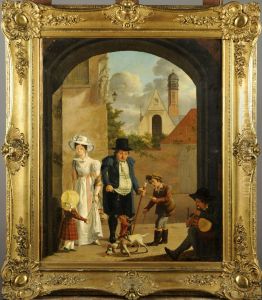Felix Devigne Paintings
Felix Devigne was a Belgian sculptor born in 1806, in a period marked by the aftermath of the Napoleonic Wars and the subsequent reshaping of Europe. His life and career unfolded during the 19th century, a time of significant political, social, and artistic changes. While Devigne is not as widely recognized as some of his contemporaries, his work nonetheless contributed to the rich tapestry of European art, reflecting the romanticism and realism that characterized the era.
Devigne was trained in the fine arts at a time when Belgium was establishing its identity, having gained independence from the Netherlands in 1830. This period was crucial for Belgian artists, who were exploring themes of national history, folklore, and the natural landscape, seeking to contribute to the cultural and national identity of the newly formed country. Devigne, however, primarily focused on sculpture, an art form that allowed him to express both the idealism of romanticism and the emerging tendencies of realism.
Throughout his career, Devigne exhibited his work in various salons and exhibitions, gaining recognition for his skill in sculpting both marble and bronze. His subjects varied from allegorical and mythological figures to more contemporary themes, showing his versatility and responsiveness to the changing tastes of the art market and the intellectual currents of his time. Despite facing the challenges common to artists of his era, including the need for patronage and the competitive nature of the art world, Devigne managed to sustain a career that, while it may not have brought him international fame, solidified his reputation within the Belgian art community.
Devigne's contribution to Belgian art is also noted for his role in education, as he was involved in the training of young artists, passing on the techniques and aesthetic values of his time. His dedication to the craft of sculpture and his commitment to the artistic community helped to nurture a generation of artists who would continue to explore and define Belgian art in the years following his death in 1862.
Felix Devigne's legacy, though not as prominent as that of some of his peers, remains an important part of the 19th-century Belgian art scene. His works, which once graced public squares, galleries, and private collections, may not all have survived the test of time, but his influence on the development of sculpture in Belgium endures. In a broader sense, Devigne's career exemplifies the challenges and achievements of artists working in the shadow of the great masters, contributing in their own ways to the evolution of European art.
